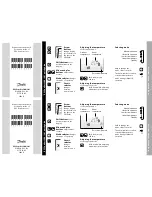
Order no. 900340.012
V1.54
Page 21
after disconnection of the plant from mains supply (and
repair!).
Low-pressure function: Delay until alarm
If a low-pressure signal is present via a parameterised
switching input and it does not disappear within the
time specified here, the compressor will be switched
off and an error message will be displayed. This fault
will only be deleted after disconnection of the plant
from mains supply (and repair!).
Alarm messages via ST-Bus during Standby
A binary mask selects the alarm messages, that are
enabled for the ST-Bus during Standby.
The bits have the following meanings:
Bit Value Function
0 1
Temperature alarm (Hi, Lo)
1 2
Sensor error
2 4
High pressure alarm
3 8
Low pressure alarm
4 16
Door alarm
5
not used
6
not used
7
not used
To determine the value to be parameterized, all bit
values must be added together. In default setting (A65
= 18) door alarm and sensor errors are allowed.
Password for parameter level
With this parameter, you can set the password for
parameter level
.
Buttons and switching
inputs
(password-protected)
…
Function buttons 1 … 8
Certain functions can be assigned to the buttons. The
buttons are arranged according to the front foil, the
layout may differ from case to case. For the function of
the buttons, refer to the operating manual of the
relevant device. The "SET"
cannot
be assigned
another function!
,
,
,
Function E1 … E4
Certain functions can be assigned to the switching
inputs.
,
,
,
Switching mode E1 … E4
Here, you can define if the switching input is used as a
make contact (normal) or break contact (inverse).
Password for parameter level
With this parameter, you can set the password for
parameter level
.
Control circuit 1
Assignment of cold store sensors
With this parameter, you can set which sensor input is
to be used as the cold room sensor. The selected
sensor must be set up accordingly in the
parameters.
Control circuit 1:
Setpoint (Set1)
Control circuit 1:
Night-time incr./decr.
Control circuit 1:
Setpoint (Set2)
With this parameter, you can set the setpoint. It will be
displayed directly if you press the SET button and can
be edited. The setting range is defined by the settings
in parameters
and
. Setpoint
becomes active
if the Set2 function is switched on via a button, a digital
switching input, the internal clock or the ST-bus.
Setpoint
becomes active if the night-time
increase/decrease function is switched on via a button,
a digital switching input, the internal clock or the ST-
bus. The value of
is added to the currently active
setpoint
or
.
Control circuit 1:
Switching mode
The switching mode of the control output can be set to
heating or refrigerating function. In the case of the
heating function, the control output is switched on if the
actual temperature is lower than the set temperature.
In the case of the refrigerating function, the output is
on if the temperature is higher than the setpoint.
Control circuit 1:
Hysteresis
In this parameter, you can specify the control hyste-
resis. A small hysteresis enables exact control, but will
result in frequent switching of the relay.
Hysteresis mode
With this parameter you can define if the hysteresis will
be active at the corresponding switching point
symmetrically or on one side only. In the case of a
one-sided hysteresis, the hysteresis will be active
below the setpoint in the case of the heating function
[
=0] and above the setpoint in the case of the
refrigerating function [
=1]. In the case of a
symmetrical hysteresis, there is no difference.









































